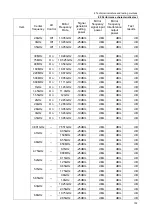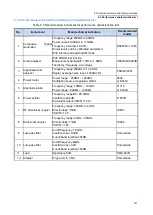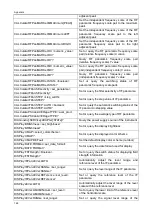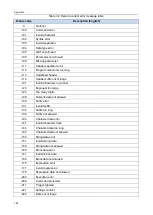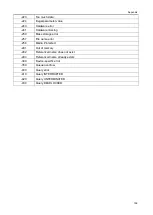
Appendix
145
Frequency range
The range between the min. frequency and max. frequency that can be measured by monitoring receiver
under the specified performance conditions. The frequency span and relevant frequency band division
shall be specified in the product specifications.
Frequency accuracy
The measured frequency shows how close the value is to the true value. It consists of absolute accuracy
and relative accuracy. The former is the actual size of the readout frequency error, and the latter is the
ratio of the readout frequency error to the ideal frequency value.
Frequency stability
Refers to the extent to which the signal frequency remains constant in the short or long term. The
short-term frequency stability can be characterized by residual FM or phase noise. Long-term frequency
stability is characterized by the aging rate.
Flatness
Corresponding to the variation of the display amplitude of the measurement frequency range of the
monitoring receiver, indicating the corresponding relationship between the displayed signal amplitude
variation and the frequency.
Measurement time
The time for the detector to output one level and spectrum measurement result. The measurement time
of the detector can be set to 500us~900s.
Measurement mode
The measurement modes include periodic and continuous measurement. The cycle measurement mode
is the output of all level check waves during the measurement time. The measurement time selected for
the continuous measurement mode is the time constant of the RC filter, which is output every 200ms
from the detector.
Input impedance
The terminal impedance presented by the receiver to the signal source, which is typically 50
. The
normal impedance of some systems (for example, the cable TV) is 75
. The degree of mismatch
between the rated impedance and the actual impedance is indicated by the voltage standing wave ratio
(VSWR).
Explicit average noise level
In case of minimum resolution bandwidth and minimum input attenuation, the video bandwidth is
reduced to minimize the peak-to-peak fluctuation of the noise, and the level observed on the monitoring
receiver display is the display average noise level, expressed in dBm. The display average noise level of
the monitoring receiver can be equivalently called to the sensitivity of the microwave analyzer.
Preselector
A bandpass filter with an adjustable center frequency located before the input mixer of the monitoring
receiver. Used to eliminate multiple responses and mirror responses in monitoring receivers, while also
improving the dynamic range of monitoring receivers.
Sensitivity
The ability of monitoring receiver to measure the minimum level signal. Sensitivity is further divided into
input signal level sensitivity and equivalent input noise sensitivity. The output produced by the former is
approximately equal to twice of input signal level of average noise value, and the latter is the average
level of internally generated noise converted to the input. The best sensitivity can be obtained at the
narrowest resolution bandwidth with minimum input attenuation. Factors affecting sensitivity include
input attenuators, preamplifier, insertion loss of front-end devices, bandwidth and noise sidebands of IF
filters. The best sensitivity may conflict with other measurement needs. For example, a smaller
resolution bandwidth increases the sweep time; 0dB input attenuation increases the input standing wave
ratio (VSWR), which reduces the measurement accuracy; and the increasing of dynamic range of the
preamplifier will affect the microwave analyzer. The relationship between sensitivity and resolution
bandwidth is as follows:
Содержание 3943B
Страница 2: ...3943B Monitoring Receiver User s Manual Ceyear Technologies Co Ltd...
Страница 4: ......



